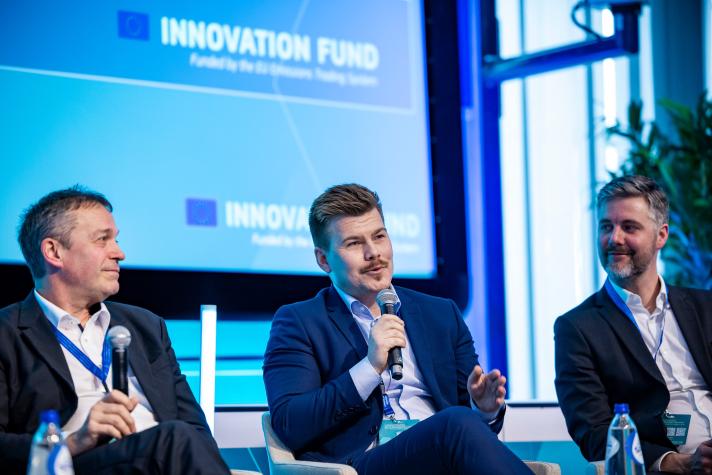
Renewable hydrogen is rapidly emerging as one of the leading clean alternatives to fossil fuels. Thanks to support from the Innovation Fund, the TopSOEC project aims to propel the large-scale production of European renewable hydrogen forward in an energy and cost-efficient way.
As the world shifts toward a sustainable future, the focus on ramping up hydrogen production has taken center stage in influential international events, from the latest UN Climate Change Conference, COP 28, to European Commission President Ursula von der Leyen's 2023 State of the Union address.
Despite being the most abundant element in our universe, hydrogen’s potential remains largely untapped. Hydrogen’s versatility allows it to store renewable energy, and act as an energy carrier, a fuel and a feedstock. Yet, in 2022, hydrogen accounted for less than 2% of Europe’s energy consumption, and 96% of those volumes were notably produced using fossil fuels, resulting in significant CO2 emissions.
With a €94 million grant from the Innovation Fund, the TopSOEC project will build Europe’s first industrial-scale Solid Oxide Electrolysis Cell (SOEC) electrolyser component factory. This factory will facilitate the mass production of electrolysers and increase renewable hydrogen production capabilities for sectors across Europe.
Ultimately, the project aims to drive down costs of renewable hydrogen, thus helping bring the EU closer to its goal of becoming climate-neutral by 2050.
Renewable hydrogen and its role in Europe’s green transition
Renewable hydrogen, classified as a ‘renewable fuel of non-biological origin (RFNBO)’ under EU regulation, is pure hydrogen obtained by electrolysis.
This process takes water and separates hydrogen from oxygen molecules by using an electric current. In the case of renewable hydrogen, electrolysis is powered by renewable energy sources, such as solar or wind, which means that its production causes zero carbon emissions.
Hydrogen can substitute fossil fuels in energy-intensive sectors such as steel and chemicals. It can also be used as a clean fuel, directly or through derivative products such as methanol, ammonia or other synthetic fuels for long-haul transport sectors like aviation and shipping.
While renewable hydrogen has considerable advantages, production costs in Europe are currently high. Swift action to lower them is necessary to achieve the EU's climate neutrality target and the objectives outlined in the REPowerEU plan, and this is where TopSOEC comes into play.
Introducing TopSOEC
TopSOEC, a pioneering project from Danish company Topsoe, has set its sights on revolutionising European renewable hydrogen production by significantly improving the energy efficiency and cost-effectiveness of its electrolysers compared to others on the market.
“SOEC is the most efficient electrolyser technology on the market to date,” explains Jesper Juul da Silva Francisco, Chief of Staff to the CEO of Topsoe PtX. This electrolyser performs at significantly higher temperatures and uses the least electricity, outperforming other technologies on the market with up to 30% more energy efficiency.
The electrolyser's innovative energy performance is due to its ability to channel waste heat from downstream production from processes producing ammonia, methanol or steel into the electrolyser, allowing for the value output for each electron to produce up to 30% more hydrogen than typical electrolysers.
Because of TopSOEC’s competitive advantage against high European energy prices, this project’s objective is to increase the scale of renewable hydrogen in the industry, thereby driving its cost to an attractive market level.
Progress
On track to be operational at the end of 2024, the SOEC Stack Module factory shell is completed and is currently installing equipment. The initial manufacturing capacity will be 500 megawatts (MW) of SOEC electrolysers and projected to grow to an annual production of 1.4 gigawatts (GW) after 2031.
The first factory output of the electrolysers will be shipped to customer sites in 2025, which should see the first impact by the end of 2025 or early 2026. Compared against hydrogen generated from fossil fuels, the TopSOEC project will avoid the emissions of around 7.6 million tonnes of CO2 in its first ten years of operations, or approximately 4.3 million return flights between Paris and New York!
As Chief of Staff to the CEO, Jesper’s expertise has played a crucial role in navigating challenges and ultimately supporting the company to where it stands today. Nonetheless, he explains that getting this first-of-a-kind factory ready to scale up was a result of almost 40 years of working on Topsoe’s SOEC technology and running a smaller-scale pilot production line before applying for Innovation Fund support.
“Topsoe had decided to take the leap of faith and scale up 100 times as we believe this would be the only way to get the SOEC’s innovative and superior performance onto the market – and drive down the cost”, says Jesper.
The time and effort it took to reach this point should be worthwhile as it is projected to have a positive impact on a local and European scale. In Herning, Denmark, where the factory is located, the project will create around 200 direct jobs and numerous indirect jobs in local supply chains, building and maintenance infrastructure, and engage with local colleges and trade schools.
The EU’s support
To reach its climate neutrality goal, the EU funds cutting-edge projects like TopSOEC through the Innovation Fund. Financed through the selling of allowances from the EU Emissions Trading System (EU ETS), the Innovation Fund is one of the world’s largest funding programmes for the deployment of net-zero and innovative technologies in EEA countries.
In this crucial time of accelerating domestic European hydrogen production, the EU is promoting renewable hydrogen production with numerous instruments set out in the EU Hydrogen Strategy and the Renewable Energy Directive, including policy framework as seen in the REPowerEU plan, the European Hydrogen Bank, and Fit for 55.
As the EU continues to move away from fossil fuels, projects like TopSOEC will help decarbonise hard-to-abate activities and pave the way for Europe’s transition to a clean and sustainable energy sector.
Details
- Publication date
- 30 September 2024
- Author
- Directorate-General for Climate Action


